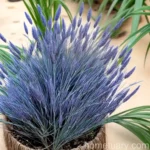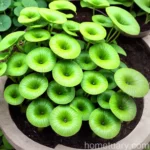Helenium ‘Flammenrad’ (Sneezeweed): A Comprehensive Plant Profile and Gardening Guide
Introduction
Helenium ‘Flammenrad’, commonly known as Sneezeweed, is a striking perennial plant that belongs to the sunflower family, Asteraceae. This vibrant and largely underused plant boasts beautiful flowers that can add a burst of color to any garden. In this comprehensive plant profile and gardening guide, we will delve into the characteristics, care tips, cultivation, and uses of Helenium ‘Flammenrad’, providing valuable insights for both novice and seasoned gardeners.
Helenium ‘Flammenrad’ Characteristics
Helenium ‘Flammenrad’ is renowned for its remarkable characteristics, making it a coveted addition to gardens. Here are some key features of this delightful plant:
- Flower Color: The blossoms of Helenium ‘Flammenrad’ come in shades of red, orange, and yellow, creating a striking and fiery display.
- Height: This plant typically grows to a height of 3 to 4 feet, making it an eye-catching addition to borders and beds.
- Bloom Time: The flowering period of Helenium ‘Flammenrad’ extends from midsummer to early autumn, ensuring a prolonged and captivating display of blooms.
- Attracts Pollinators: The vibrant flowers of Sneezeweed are highly attractive to pollinators, especially butterflies and bees, making it an excellent choice for wildlife gardens.
These notable characteristics contribute to the plant’s appeal and suitability for a wide range of gardening applications.
Sneezeweed Plant Profile
The Sneezeweed’s plant profile encompasses various aspects of its growth and development, offering an in-depth look into its requirements and traits. As a plant scientist, it’s crucial to understand the fundamental elements of this species. Below, we’ll explore the plant’s profile in detail, covering essential factors such as its cultivation, care guidelines, and environmental preferences.
Cultivation
Cultivating Helenium ‘Flammenrad’ involves a set of practices that are integral to its successful growth and development. This section will outline the various aspects of cultivating Sneezeweed, from planting to maintenance.
Planting
When selecting a location for planting Helenium ‘Flammenrad’, consider the following factors:
- Soil: Sneezeweed thrives in well-drained, fertile soil, preferably with a slightly acidic to neutral pH level.
- Sunlight: Choose a spot that receives full sun to partial shade, as adequate sunlight is essential for optimal growth and flowering.
- Spacing: Provide ample space between plants, typically 18 to 24 inches, to accommodate their mature size and ensure proper air circulation.
Water
Proper watering is essential for the overall health and vigor of Helenium ‘Flammenrad’. Here are some watering guidelines:
- Regular Moisture: While Sneezeweed is relatively drought-tolerant once established, consistent moisture is beneficial, especially during the hotter months.
- Avoid Waterlogging: Ensure that the soil is well-drained to prevent waterlogging, as excessive moisture can lead to root rot and other issues.
Sunlight
Understanding the sunlight requirements of Helenium ‘Flammenrad’ is crucial for its successful cultivation. Here’s an overview of its sunlight preferences:
- Full Sun: Sneezeweed thrives in full sun locations, where it can receive at least 6 to 8 hours of direct sunlight daily.
- Partial Shade: While it prefers full sun, Sneezeweed can tolerate partial shade, especially in regions with intense afternoon sun or during exceptionally hot summers.
Fertilizer
Applying the right type and amount of fertilizer is key to promoting healthy growth and prolific flowering in Helenium ‘Flammenrad’. Consider the following fertilizer recommendations:
- Balanced Fertilizer: Use a balanced, slow-release fertilizer in early spring to provide essential nutrients for robust growth and vibrant blooms.
- Frequency: Apply fertilizer once in early spring, following the manufacturer’s guidelines regarding the application rate.
Soil
The soil composition and quality profoundly impact the growth and performance of Sneezeweed. Understanding the ideal soil conditions is imperative for cultivating this plant successfully:
- Well-Drained Soil: Helenium ‘Flammenrad’ thrives in well-drained soil to prevent waterlogging and promote healthy root development.
- Fertility: Incorporate organic matter such as compost into the soil before planting to enhance its fertility and texture.
Pruning
Pruning plays a vital role in maintaining the health and appearance of Helenium ‘Flammenrad’, and should be done with careful consideration of the plant’s growth habits:
- Deadheading: Regular deadheading of spent blooms encourages continuous flowering and prevents the plant from diverting energy into seed production.
- Mildew Removal: If the plant is susceptible to powdery mildew, promptly remove affected foliage to prevent the spread of the disease and maintain overall plant vigor.
Propagation
Propagating Helenium ‘Flammenrad’ allows for the expansion of its presence in the garden and provides an opportunity to share its beauty with others. The following methods can be used for propagation:
- Division: Divide mature clumps of Sneezeweed in early spring or fall, ensuring that each division has sufficient roots and shoots for successful establishment.
- Seeds: Collect seeds from the plant after flowering and sow them indoors or directly in the garden, following proper seed starting and germination techniques.
Container Popularity
With its vibrant blooms and striking foliage, Helenium ‘Flammenrad’ is increasingly popular as a container plant. When considering container cultivation, bear in mind the following points:
- Size: Choose a sufficiently large container to accommodate the plant’s mature size and provide ample space for root development.
- Drainage: Ensure that the container has adequate drainage holes to prevent waterlogging, as excess moisture can be detrimental to the plant’s health.
Common Diseases
As with many plants, Helenium ‘Flammenrad’ is susceptible to certain diseases that can impact its vitality and appearance. Recognizing and addressing these diseases is crucial for maintaining plant health:
- Powdery Mildew: Sneezeweed is prone to powdery mildew, a fungal disease that manifests as a whitish, powdery coating on the foliage. Proper air circulation and prompt removal of affected leaves can help manage this condition.
- Root Rot: Excessive moisture or waterlogged soil can lead to root rot, causing wilting and decline in the plant. Ensure well-drained soil and appropriate watering practices to prevent this issue.
Common Pests
While generally resistant to pests, Helenium ‘Flammenrad’ may occasionally encounter pest infestations that need attention for effective management:
- Aphids: These small, sap-sucking insects can infest Sneezeweed, causing distorted growth and honeydew secretion. Use insecticidal soap or neem oil to control aphids.
- Spider Mites: Spider mite infestations can result in stippled and discolored foliage. Regularly spray the plant with water to dislodge the mites, and consider applying horticultural oil for control.
Botanist’s Tips
As a plant scientist, it’s essential to provide practical tips for the successful cultivation and care of Helenium ‘Flammenrad’. The following tips, based on scientific knowledge and experience, can aid in optimizing the growing conditions and promoting the health and beauty of this charismatic plant:
- Mulching: Apply a layer of organic mulch around Sneezeweed to conserve soil moisture, suppress weeds, and provide insulation during temperature fluctuations.
- Companion Planting: Pair Helenium ‘Flammenrad’ with complementary plants that share similar cultural requirements, such as Echinacea and Rudbeckia, to create visually appealing and ecologically beneficial garden compositions.
- Pollinator Support: Incorporate Sneezeweed in pollinator-friendly gardens and landscapes to provide essential nectar and habitat for butterflies, bees, and other beneficial insects.
Fun Facts
Uncover fascinating and lesser-known facts about Helenium ‘Flammenrad’ that showcase its unique characteristics and ecological significance:
- Mythological Origins: The genus name “Helenium” is derived from Helen of Troy, with the plant purportedly emerging from the tears she shed during the Trojan War, further adding to its allure and symbolism.
- Ethnobotanical Uses: Certain indigenous tribes used Helenium species, including Sneezeweed, for medicinal purposes, employing its properties in herbal remedies for various ailments.
- Ecosystem Benefits: Sneezeweed plays a vital role in supporting biodiversity by attracting and nourishing a diverse array of pollinators, contributing to the overall ecological balance of natural habitats.
The interweaving of science, mythology, and ecological relevance underscores the multifaceted appeal of Helenium ‘Flammenrad’ as a captivating and essential component of diverse ecosystems.
Conclusion
In this comprehensive plant profile and gardening guide, we’ve explored the captivating world of Helenium ‘Flammenrad’ (Sneezeweed), unraveling its distinctive characteristics, cultivation techniques, and ecological relevance. By integrating scientific insights with practical recommendations, we’ve gained a deeper understanding of this remarkable plant and its role in sustainable and biodiverse gardening practices.
As we continue to appreciate and steward the natural world, the cultivation and conservation of captivating plants such as Helenium ‘Flammenrad’ contribute to the enrichment of our lives and the preservation of vital habitats for wildlife. Embracing the knowledge and beauty of Sneezeweed empowers us to cultivate vibrant, sustainable landscapes that support biodiversity and inspire a deeper connection with nature.















